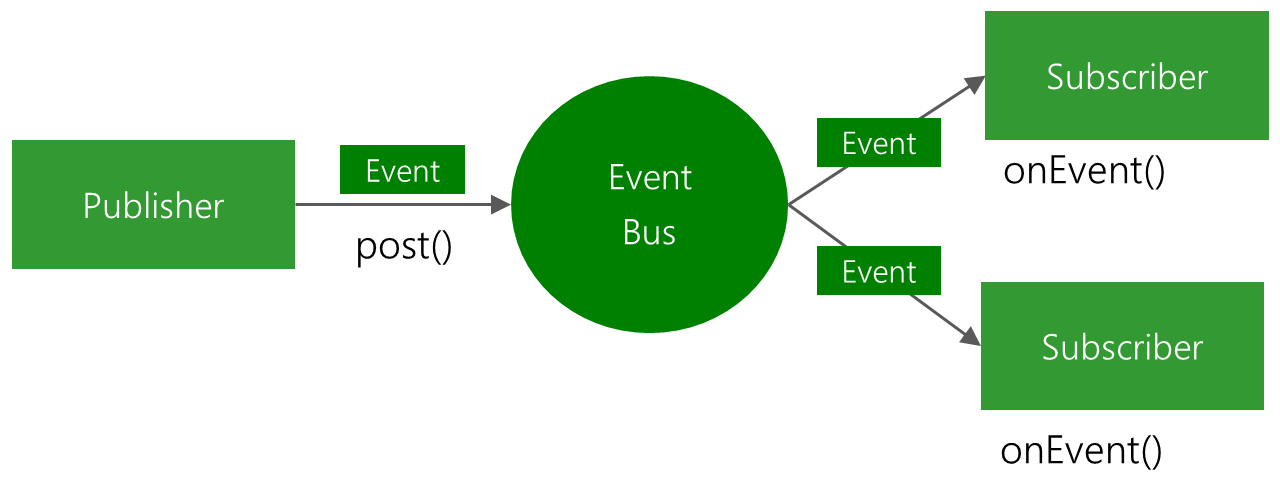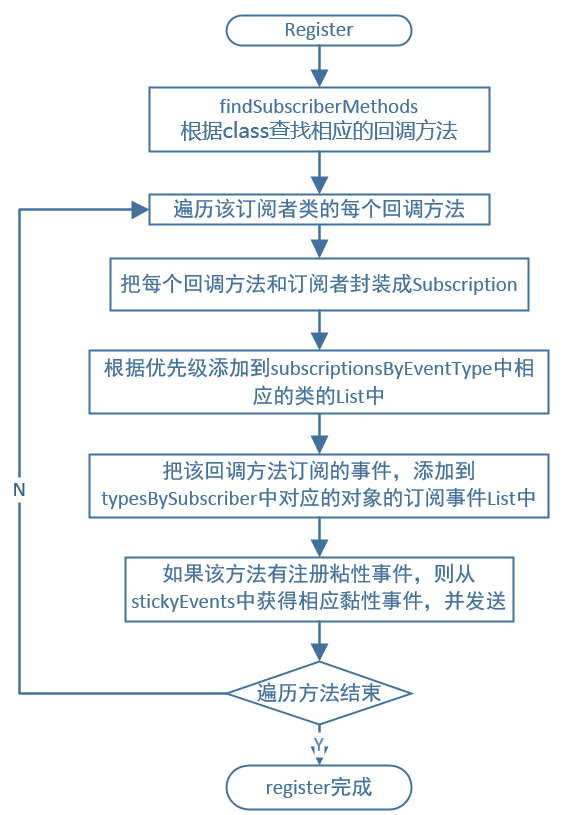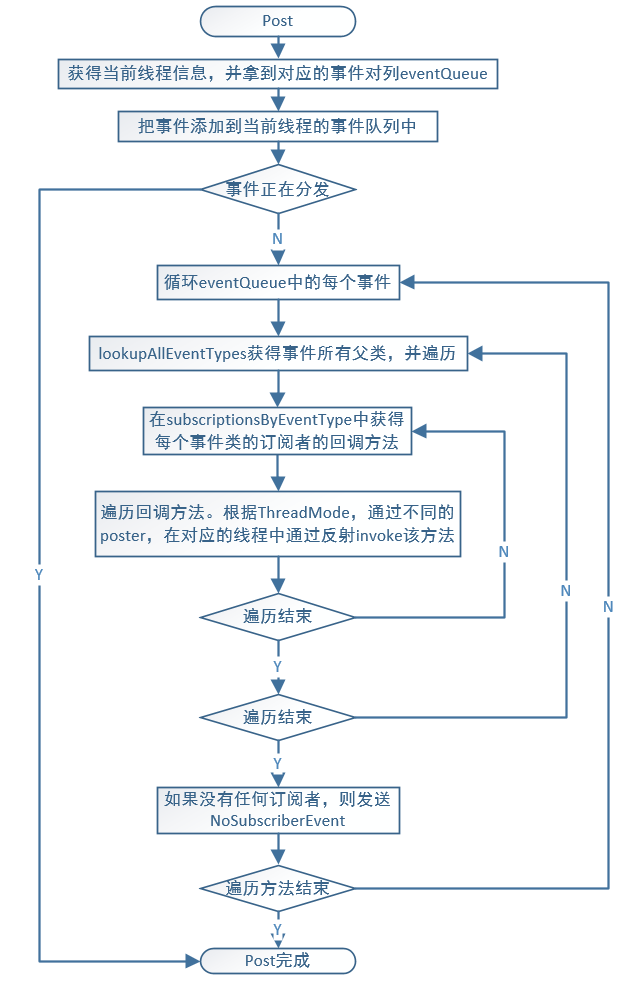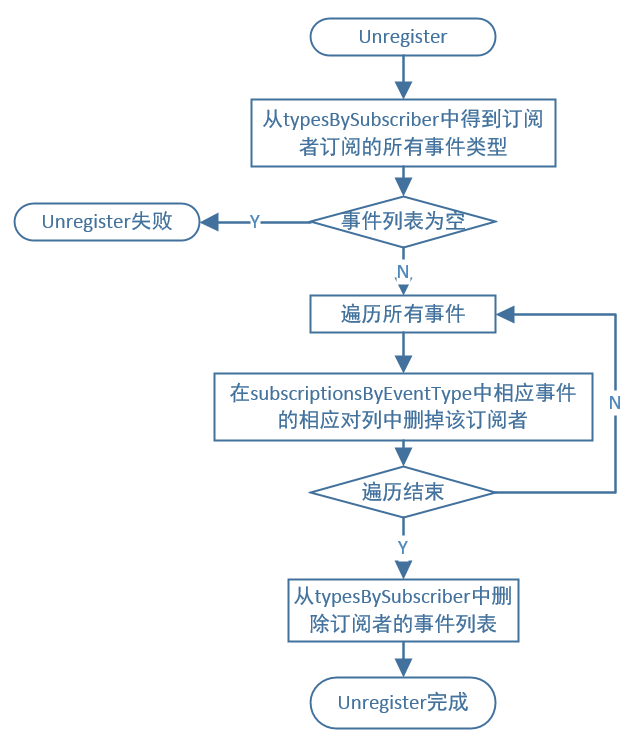在接入微信支付的时候,为了传递支付结果的值,就使用了EventBus,那时候只是简单了解了EventBus的使用,现在有时间就来深入研究一下EventBus的实现原理和源码。
EventBus的介绍
可能有部分同学还没有使用过EventBus,那我们首先来了解一下EventBus的作用。
EventBus是一款基于观察者模式的事件发布/订阅框架。简化了应用程序内各组件间、组件与后台线程间的通讯。优点是开销小,优化更优雅,以及将发送者和接受者解耦。如果Activity和Activity进行交互大家都知道,而Fragment和Fragment之间通讯写法五花八门、跨线程/跨界面我们就开始头疼了,那么我们来学习一下EventBus3。
EventBus的主要三要素:
- Event:事件。可以是任意类型的对象。
- Subscriber:事件订阅者。在EventBus3之前消息处理通过在onEvent、onEventMainTain、onEventBackgroundThread和onEventAsync,他们代表着四种线程模型。在EventBus3之后,事件处理的方法可以按照自己需要命名,但是需要添加一个注解@Subscribe和指定线程模型。
- Publisher:事件发布者。可以在任意线程和位置发送事件。
EventBus的四种ThreadMode
- POSTING(默认):如果使用事件处理函数指定了线程模型为POSTING,那么该事件在哪个线程发布出来的,事件处理函数就会在这个线程中运行,也就是说发布事件和接收事件在同一个线程。在线程模型为POSTING的事件处理函数中精良避免执行耗时操作,因为它会阻塞事件的传递。
- MAIN:事件的处理会在UI线程中执行,事件处理的时间不能太长,可能出现ANR。
- BACKFROUND:如果事件在UI线程发布的,那么该线程就会在新的线程中运行,如果事件本来就是子线程发布的,那么该事件处理函数直接在发布事件的线程中执行,在此事件处理函数中禁止进行UI更新操作。
- ASYNC:无论事件在哪个线程发布,该事件处理函数都会在新建的子线程中执行,同样,此事件处理函数中禁止进行UI更新操作。
EventBus的基本用法
Android Studio 配置Gradle:
compile 'org.greenrobot:eventbus:3.0.0'定义一个事件类
public class EventBusEvent {
private String message;
public EventBusEvent(String message) {
this.message = message;
}
public String getMessage() {
return message;
}
public void setMessage(String message) {
this.message = message;
}
}注册事件
EventBus.getDefault().register(this);发送事件
EventBus.getDefault().post(message);处理事件

@Subscribe(threadMode = ThreadMode.BACKGROUND)
public void XXXXXX(EventBusEvent message) {
}取消事件订阅
EventBus.getDefault().unregister(this);EventBus源码分析
我们首先从开头注册开始分析EventBus.getDefault()其实就是一个单例。
/** Convenience singleton for apps using a process-wide EventBus instance. */
public static EventBus getDefault() {
if (defaultInstance == null) {
synchronized (EventBus.class) {
if (defaultInstance == null) {
defaultInstance = new EventBus();
}
}
}
return defaultInstance;
}使用双重判断方式,防止并发。接着看看 new EventBus()。
/**
* Creates a new EventBus instance; each instance is a separate scope in which events are delivered. To use a
* central bus, consider {@link #getDefault()}.
*/
public EventBus() {
this(DEFAULT_BUILDER);
}所在的参DEFAULT_BUILDER,在EventBus.class的全局进行初始化:
private static final EventBusBuilder DEFAULT_BUILDER = new EventBusBuilder();在看一下this调用了EventBus的另一构造方法。使用的是现在常用的Builder模式:
EventBus(EventBusBuilder builder) {
subscriptionsByEventType = new HashMap<>();
typesBySubscriber = new HashMap<>();
stickyEvents = new ConcurrentHashMap<>();
mainThreadPoster = new HandlerPoster(this, Looper.getMainLooper(), 10);
backgroundPoster = new BackgroundPoster(this);
asyncPoster = new AsyncPoster(this);
···//一系列builder赋值
}我们得到EventBus对象后,我们就可以调用register方法。
public void register(Object subscriber) {
Class<?> subscriberClass = subscriber.getClass();
List<SubscriberMethod> subscriberMethods = subscriberMethodFinder.findSubscriberMethods(subscriberClass);
synchronized (this) {
for (SubscriberMethod subscriberMethod : subscriberMethods) {
subscribe(subscriber, subscriberMethod);
}
}
}先是获取订阅者的class,接着交给subscriberMethodFinder.findSubscriberMethods()处理,返回的是List类型的集合,对于SubscriberMethod类中,主要是用于保存订阅方法的Method对象,线程模式、事件类型、优先级、是否是粘性事件等属性。下面我们直接看看这个方法:
List<SubscriberMethod> findSubscriberMethods(Class<?> subscriberClass) {
//从缓存中取出subscriberMethods,如果有则直接返回该已取的方法
List<SubscriberMethod> subscriberMethods = METHOD_CACHE.get(subscriberClass);
if (subscriberMethods != null) {
return subscriberMethods;
}
//从EventBusBuilder中可知,ignoreGeneratedIndex一般为false
if (ignoreGeneratedIndex) {
subscriberMethods = findUsingReflection(subscriberClass);
} else {
subscriberMethods = findUsingInfo(subscriberClass);
}
if (subscriberMethods.isEmpty()) {
throw new EventBusException("Subscriber " + subscriberClass
+ " and its super classes have no public methods with the @Subscribe annotation");
} else {
//将获取到的subscriberMethods放入缓存中
METHOD_CACHE.put(subscriberClass, subscriberMethods);
return subscriberMethods;
}
}首先从缓存中查找,如果缓存没有会根据ignoreGeneratedIndex选择如何查找订阅方法,ignoreGeneratedIndex默认false,可以通过EventBusBuilder来设置它的值。我们一般是通过getDefault()获取默认的EventBus对象,也就ignoreGeneratedIndex为false的情况,这时调用的是
findUsingInfo(),我们接着看看这个方法:
private List<SubscriberMethod> findUsingInfo(Class<?> subscriberClass) {
//准备一个findstate,该findState保存了订阅者类信息
FindState findState = prepareFindState();
//对FindState初始化
findState.initForSubscriber(subscriberClass);
while (findState.clazz != null) {
findState.subscriberInfo = getSubscriberInfo(findState);
if (findState.subscriberInfo != null) {
SubscriberMethod[] array = findState.subscriberInfo.getSubscriberMethods();
for (SubscriberMethod subscriberMethod : array) {
if (findState.checkAdd(subscriberMethod.method, subscriberMethod.eventType)) {
findState.subscriberMethods.add(subscriberMethod);
}
}
} else {
findUsingReflectionInSingleClass(findState);
}
findState.moveToSuperclass();
}
return getMethodsAndRelease(findState);
}上面用到了FindState这个内部类是保存订阅者的信息,我们看看它的内部结构:
static class FindState {
final List<SubscriberMethod> subscriberMethods = new ArrayList<>();
final Map<Class, Object> anyMethodByEventType = new HashMap<>();
final Map<String, Class> subscriberClassByMethodKey = new HashMap<>();
final StringBuilder methodKeyBuilder = new StringBuilder(128);
Class<?> subscriberClass;
Class<?> clazz;
boolean skipSuperClasses;
SubscriberInfo subscriberInfo;
void initForSubscriber(Class<?> subscriberClass) {
this.subscriberClass = clazz = subscriberClass;
skipSuperClasses = false;
subscriberInfo = null;
}
···
}可以看出,该内部类保存了订阅者及其订阅方法的信息,用Map一一对应来保存,接着利用initForSubscriber()进行初始化,在初始化的时候subscriberInfo设置为null,所以SubscriberMethodFinder的findUsingInfo()里面在初始化后会调用findUsingReflectionInSingleClass()方法。那么我们接着看看这个方法:
private void findUsingReflectionInSingleClass(FindState findState) {
Method[] methods;
try {
// This is faster than getMethods, especially when subscribers are fat classes like Activities
methods = findState.clazz.getDeclaredMethods();
} catch (Throwable th) {
// Workaround for java.lang.NoClassDefFoundError, see https://github.com/greenrobot/EventBus/issues/149
methods = findState.clazz.getMethods();
findState.skipSuperClasses = true;
}
for (Method method : methods) {
int modifiers = method.getModifiers();
if ((modifiers & Modifier.PUBLIC) != 0 && (modifiers & MODIFIERS_IGNORE) == 0) {
Class<?>[] parameterTypes = method.getParameterTypes();
if (parameterTypes.length == 1) {
//获取该方法的@Subscribe注解
Subscribe subscribeAnnotation = method.getAnnotation(Subscribe.class);
if (subscribeAnnotation != null) {
Class<?> eventType = parameterTypes[0];
if (findState.checkAdd(method, eventType)) {
ThreadMode threadMode = subscribeAnnotation.threadMode();
findState.subscriberMethods.add(new SubscriberMethod(method, eventType, threadMode,
subscribeAnnotation.priority(), subscribeAnnotation.sticky()));
}
}
} else if (strictMethodVerification && method.isAnnotationPresent(Subscribe.class)) {
String methodName = method.getDeclaringClass().getName() + "." + method.getName();
throw new EventBusException("@Subscribe method " + methodName +
"must have exactly 1 parameter but has " + parameterTypes.length);
}
} else if (strictMethodVerification && method.isAnnotationPresent(Subscribe.class)) {
String methodName = method.getDeclaringClass().getName() + "." + method.getName();
throw new EventBusException(methodName +
" is a illegal @Subscribe method: must be public, non-static, and non-abstract");
}
}
}这里主要是使用了Java的反射和对注解的解析。首先是通过反射来获取订阅者中的所有方法,并根据方法的类型、参数和注解来找到订阅方法。找到订阅方法后将订阅方法相关信息保存到FindState中。
通过上述的方法,把SubscriberMethods不断逐层返回,返回到EventBus.register(),并开始遍历每一个订阅方法,并调用subscribe(subscriber, subscriberMethod)方法对所有订阅方法进行注册,那么我们接着去这方法的实现:
// Must be called in synchronized block
private void subscribe(Object subscriber, SubscriberMethod subscriberMethod) {
Class<?> eventType = subscriberMethod.eventType;
//根据订阅者和订阅方法构造一个订阅事件
Subscription newSubscription = new Subscription(subscriber, subscriberMethod);
//获取当前订阅事件中的Subscription的集合
CopyOnWriteArrayList<Subscription> subscriptions = subscriptionsByEventType.get(eventType);
//该事件对应的Subscription的集合不存在,则重新创建并保存在subscriptionsByEventType中
if (subscriptions == null) {
subscriptions = new CopyOnWriteArrayList<>();
subscriptionsByEventType.put(eventType, subscriptions);
} else {
//订阅者已经注册则抛出一个EventBusException异常
if (subscriptions.contains(newSubscription)) {
throw new EventBusException("Subscriber " + subscriber.getClass() + " already registered to event "
+ eventType);
}
}
//遍历订阅事件,根据优先级来设置放进subscriptions,优先级高的会先被通知
int size = subscriptions.size();
for (int i = 0; i <= size; i++) {
if (i == size || subscriberMethod.priority > subscriptions.get(i).subscriberMethod.priority) {
subscriptions.add(i, newSubscription);
break;
}
}
//根据订阅者来获取它的所有订阅事件集合
List<Class<?>> subscribedEvents = typesBySubscriber.get(subscriber);
if (subscribedEvents == null) {
subscribedEvents = new ArrayList<>();
//把订阅者、事件放进typesBySubscriber这个Map中
typesBySubscriber.put(subscriber, subscribedEvents);
}
//将当前的订阅事件添加到subscribedEvents中
subscribedEvents.add(eventType);
if (subscriberMethod.sticky) {
if (eventInheritance) {
//粘性事件处理
// Existing sticky events of all subclasses of eventType have to be considered.
// Note: Iterating over all events may be inefficient with lots of sticky events,
// thus data structure should be changed to allow a more efficient lookup
// (e.g. an additional map storing sub classes of super classes: Class -> List<Class>).
Set<Map.Entry<Class<?>, Object>> entries = stickyEvents.entrySet();
for (Map.Entry<Class<?>, Object> entry : entries) {
Class<?> candidateEventType = entry.getKey();
if (eventType.isAssignableFrom(candidateEventType)) {
Object stickyEvent = entry.getValue();
checkPostStickyEventToSubscription(newSubscription, stickyEvent);
}
}
} else {
Object stickyEvent = stickyEvents.get(eventType);
checkPostStickyEventToSubscription(newSubscription, stickyEvent);
}
}
}订阅的代码主要就是做两件事,第一件是将我们的订阅方法和订阅者封装到subscriptionsByEventType和typesBySubscriber中;subscriptionsByEventType是我们投递订阅事件的时候,就是根据我们的EventType找到我们的订阅事件,从而去分发事件,处理事件的。typesBySubscriber在调用unregister()的时候,根据订阅者找到EventType,再根据EventType找到订阅事件,从而对订阅者进行解绑。
第二件是如果是粘性事件的话,就立马执行。
分析完事件注册后,到事件发送,我们通过post方法来进行对事件的提交。接下来我们看一下post的方法:
/** Posts the given event to the event bus. */
public void post(Object event) {
//PostingThreadState保存着事件队列和线程状态信息
PostingThreadState postingState = currentPostingThreadState.get();
//获取事件队列,并将当前事件插入到事件队列中
List<Object> eventQueue = postingState.eventQueue;
eventQueue.add(event);
if (!postingState.isPosting) {
//判断当前线程是否主线程
postingState.isMainThread = Looper.getMainLooper() == Looper.myLooper();
postingState.isPosting = true;
if (postingState.canceled) {
throw new EventBusException("Internal error. Abort state was not reset");
}
try {
//处理队列中的所有事件
while (!eventQueue.isEmpty()) {
postSingleEvent(eventQueue.remove(0), postingState);
}
} finally {
postingState.isPosting = false;
postingState.isMainThread = false;
}
}
}代码很清晰,首先是获取一个PostingThreadState,我们看一下PostingThreadState:
/** For ThreadLocal, much faster to set (and get multiple values). */
final static class PostingThreadState {
final List<Object> eventQueue = new ArrayList<Object>();
boolean isPosting;
boolean isMainThread;
Subscription subscription;
Object event;
boolean canceled;
}看出该PostingThreadState封装了当前线程的信息,以及订阅者、订阅事件等。那么我们看一下怎么获取PostingThreadState的:
private final ThreadLocal<PostingThreadState> currentPostingThreadState = new ThreadLocal<PostingThreadState>() {
@Override
protected PostingThreadState initialValue() {
return new PostingThreadState();
}
};原来 currentPostingThreadState是一个ThreadLocal。我们回到post()方法里,继续是一个while循环,不断从队列中取出时间,调用postSingleEvent()。进去看一下:
private void postSingleEvent(Object event, PostingThreadState postingState) throws Error {
Class<?> eventClass = event.getClass();
boolean subscriptionFound = false;
if (eventInheritance) {
List<Class<?>> eventTypes = lookupAllEventTypes(eventClass);
int countTypes = eventTypes.size();
//遍历所有事件
for (int h = 0; h < countTypes; h++) {
Class<?> clazz = eventTypes.get(h);
subscriptionFound |= postSingleEventForEventType(event, postingState, clazz);
}
} else {
subscriptionFound = postSingleEventForEventType(event, postingState, eventClass);
}
//如果没找到订阅该事件的订阅者
if (!subscriptionFound) {
if (logNoSubscriberMessages) {
Log.d(TAG, "No subscribers registered for event " + eventClass);
}
if (sendNoSubscriberEvent && eventClass != NoSubscriberEvent.class &&
eventClass != SubscriberExceptionEvent.class) {
post(new NoSubscriberEvent(this, event));
}
}
}eventInheritance表示是否向上查找事件的父类,它的默认值为true,可以通过在EventBusBuilder中来进行配置。当eventInheritance为true时,则通过lookupAllEventTypes找到所有的父类事件并存在List中,然后通过postSingleEventForEventType方法对事件逐一处理,接下来看看postSingleEventForEventType方法:
private boolean postSingleEventForEventType(Object event, PostingThreadState postingState, Class<?> eventClass) {
CopyOnWriteArrayList<Subscription> subscriptions;
synchronized (this) {
subscriptions = subscriptionsByEventType.get(eventClass);
}
if (subscriptions != null && !subscriptions.isEmpty()) {
//将该事件的event和对应的Subscription中的信息(包扩订阅者类和订阅方法)传递给postingState
for (Subscription subscription : subscriptions) {
postingState.event = event;
postingState.subscription = subscription;
boolean aborted = false;
try {
postToSubscription(subscription, event, postingState.isMainThread);
aborted = postingState.canceled;
} finally {
postingState.event = null;
postingState.subscription = null;
postingState.canceled = false;
}
if (aborted) {
break;
}
}
return true;
}
return false;
}同步取出该事件对应的subscriptions集合并遍历该集合,将事件的event和subscription传进postToSubscription()方法里。
private void postToSubscription(Subscription subscription, Object event, boolean isMainThread) {
switch (subscription.subscriberMethod.threadMode) {
case POSTING:
invokeSubscriber(subscription, event);
break;
case MAIN:
if (isMainThread) {
invokeSubscriber(subscription, event);
} else {
mainThreadPoster.enqueue(subscription, event);
}
break;
case BACKGROUND:
if (isMainThread) {
backgroundPoster.enqueue(subscription, event);
} else {
invokeSubscriber(subscription, event);
}
break;
case ASYNC:
asyncPoster.enqueue(subscription, event);
break;
default:
throw new IllegalStateException("Unknown thread mode: " + subscription.subscriberMethod.threadMode);
}
}根据取出的订阅方法的线程模式分别处理。这里我们根据图来理顺一下。
在我们的对应界面的生命周期中,会在onDestory()中对订阅者取消注册。那么我们来看一下unregister()方法。
/** Unregisters the given subscriber from all event classes. */
public synchronized void unregister(Object subscriber) {
List<Class<?>> subscribedTypes = typesBySubscriber.get(subscriber);
if (subscribedTypes != null) {
for (Class<?> eventType : subscribedTypes) {
unsubscribeByEventType(subscriber, eventType);
}
typesBySubscriber.remove(subscriber);
} else {
Log.w(TAG, "Subscriber to unregister was not registered before: " + subscriber.getClass());
}
}typesBySubscriber我们在订阅者注册的过程中讲到过这个属性,他根据订阅者找到EventType,然后根据EventType和订阅者来得到订阅事件来对订阅者进行解绑。 看一下unsubscribeByEventType():
/** Only updates subscriptionsByEventType, not typesBySubscriber! Caller must update typesBySubscriber. */
private void unsubscribeByEventType(Object subscriber, Class<?> eventType) {
List<Subscription> subscriptions = subscriptionsByEventType.get(eventType);
if (subscriptions != null) {
int size = subscriptions.size();
for (int i = 0; i < size; i++) {
Subscription subscription = subscriptions.get(i);
if (subscription.subscriber == subscriber) {
subscription.active = false;
subscriptions.remove(i);
i--;
size--;
}
}
}
}逻辑十分清晰,从从subscriptionsByEventType中获取相应的subscriptions 集合,并遍历所有的subscriptions,逐一移除。
总结:
整个EventBus是基于观察者模式而构建的,我们看一下EventBus的核心架构。

EventBus好处很明显,简化我们某些界面、线程间的通讯,实现的代码也很简单。但是由于EventBus的优点导致实现的代码可能分散得较为严重,会出现后期维护较为困难,代码的可读性大大下降。
参考:
【Bugly干货分享】老司机教你 “飙” EventBus 3



